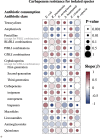Trends and correlation between antibacterial consumption and carbapenem resistance in gram-negative bacteria in a tertiary hospital in China from 2012 to 2019
- PMID: 34001022
- PMCID: PMC8130264
- DOI: 10.1186/s12879-021-06140-5
Trends and correlation between antibacterial consumption and carbapenem resistance in gram-negative bacteria in a tertiary hospital in China from 2012 to 2019
Abstract
Background: To investigate the trends and correlation between antibacterial consumption and carbapenem resistance in Gram-negative bacteria from 2012 to 2019 in a tertiary-care teaching hospital in southern China.
Methods: This retrospective study included data from hospital-wide inpatients collected between January 2012 and December 2019. Data on antibacterial consumption were expressed as defined daily doses (DDDs)/1000 patient-days. Antibacterials were classified according to the Anatomical Therapeutic Chemical (ATC) classification system. The trends in antimicrobial usage and resistance were analyzed by linear regression, while Pearson correlation analysis was used for assessing correlations.
Results: An increasing trend in the annual consumption of tetracyclines, β-lactam/β-lactamase inhibitor (BL/BLI) combinations, and carbapenems was observed (P < 0.05). Carbapenem resistance in Acinetobacter baumannii (A. baumannii) significantly increased (P < 0.05) from 18% in 2012 to 60% in 2019. Moreover, significant positive correlations were found between resistance to carbapenems in A. baumannii (P < 0.05) and Escherichia coli (E. coli; P < 0.05) and consumption of carbapenems, while the resistance rate of A. baumannii to carbapenems was positively correlated with cephalosporin/β-lactamase inhibitor (C/BLI) combinations (P < 0.01) and tetracyclines usage (P < 0.05). We also found that use of quinolones was positively correlated with the resistance rate of Burkholderia cepacia (B. cepacia) to carbapenems (P < 0.05), and increasing uses of carbapenems (P < 0.01) and penicillin/β-Lactamase inhibitor (P/BLI) combinations (P < 0.01) were significantly correlated with reduced resistance of Enterobacter cloacae (E. cloacae) to carbapenems.
Conclusion: These results revealed significant correlations between consumption of antibiotics and carbapenem resistance rates in Gram-negative bacteria. Implementing proper management strategies and reducing the unreasonable use of antibacterial drugs may be an effective measure to reduce the spread of carbapenem-resistant Gram-negative bacteria (CRGN), which should be confirmed by further studies.
Keywords: Antibacterial consumption; Carbapenems; Drug resistance; Gram-negative bacteria; Microbial.
Conflict of interest statement
The authors declare that they have no competing interests.
Figures





Similar articles
-
Association between antibiotic consumption and the rate of carbapenem-resistant Gram-negative bacteria from China based on 153 tertiary hospitals data in 2014.Antimicrob Resist Infect Control. 2018 Nov 19;7:137. doi: 10.1186/s13756-018-0430-1. eCollection 2018. Antimicrob Resist Infect Control. 2018. PMID: 30479750 Free PMC article.
-
Antibiotic consumption versus the prevalence of carbapenem-resistant Gram-negative bacteria at a tertiary hospital in China from 2011 to 2017.J Infect Public Health. 2019 Mar-Apr;12(2):195-199. doi: 10.1016/j.jiph.2018.10.003. Epub 2018 Oct 29. J Infect Public Health. 2019. PMID: 30385238
-
Association between the rate of fluoroquinolones-resistant gram-negative bacteria and antibiotic consumption from China based on 145 tertiary hospitals data in 2014.BMC Infect Dis. 2020 Apr 7;20(1):269. doi: 10.1186/s12879-020-04981-0. BMC Infect Dis. 2020. PMID: 32264851 Free PMC article.
-
Cefiderocol: A Siderophore Cephalosporin with Activity Against Carbapenem-Resistant and Multidrug-Resistant Gram-Negative Bacilli.Drugs. 2019 Feb;79(3):271-289. doi: 10.1007/s40265-019-1055-2. Drugs. 2019. PMID: 30712199 Review.
-
Evolving resistance landscape in gram-negative pathogens: An update on β-lactam and β-lactam-inhibitor treatment combinations for carbapenem-resistant organisms.Pharmacotherapy. 2024 Aug;44(8):658-674. doi: 10.1002/phar.2950. Epub 2024 Jul 1. Pharmacotherapy. 2024. PMID: 38949413 Review.
Cited by
-
Trends of Phase I Clinical Trials of New Drugs in Mainland China Over the Past 10 Years (2011-2020).Front Med (Lausanne). 2021 Dec 17;8:777698. doi: 10.3389/fmed.2021.777698. eCollection 2021. Front Med (Lausanne). 2021. PMID: 34977078 Free PMC article.
-
Relationship between Antibiotic Consumption and Resistance: A Systematic Review.Can J Infect Dis Med Microbiol. 2024 Mar 5;2024:9958678. doi: 10.1155/2024/9958678. eCollection 2024. Can J Infect Dis Med Microbiol. 2024. PMID: 38476862 Free PMC article. Review.
-
Modification of the Antibiotic, Colistin, with Dextrin Causes Enhanced Cytotoxicity and Triggers Apoptosis in Myeloid Leukemia.Int J Nanomedicine. 2024 Jun 7;19:5419-5437. doi: 10.2147/IJN.S449185. eCollection 2024. Int J Nanomedicine. 2024. PMID: 38868592 Free PMC article.
-
Investigation and analysis of carbapenem-resistant gram-negative bacterial infection rates across hospitals in Shandong Province in China.Front Public Health. 2022 Nov 7;10:1014995. doi: 10.3389/fpubh.2022.1014995. eCollection 2022. Front Public Health. 2022. PMID: 36420011 Free PMC article.
-
Plethora of Antibiotics Usage and Evaluation of Carbapenem Prescribing Pattern in Intensive Care Units: A Single-Center Experience of Malaysian Academic Hospital.Antibiotics (Basel). 2022 Aug 30;11(9):1172. doi: 10.3390/antibiotics11091172. Antibiotics (Basel). 2022. PMID: 36139951 Free PMC article.
References
-
- Tacconelli E, Sifakis F, Harbarth S, Schrijver R, van Mourik M, Voss A, Sharland M, Rajendran NB, Rodríguez-Baño J, Bielicki J, de Kraker M, Gandra S, Gastmeier P, Gilchrist K, Gikas A, Gladstone BP, Goossens H, Jafri H, Kahlmeter G, Leus F, Luxemburger C, Malhotra-Kumar S, Marasca G, McCarthy M, Navarro MD, Nuñez-Nuñez M, Oualim A, Price J, Robert J, Sommer H, von Cube M, Vuong C, Wiegand I, Witschi AT, Wolkewitz M. Surveillance for control of antimicrobial resistance. Lancet Infect Dis. 2018;18(3):e99–e106. doi: 10.1016/S1473-3099(17)30485-1. - DOI - PubMed
-
- WHO Antimicrobial Resistance: Global Report on Surveillance. Australas Med J. 2014;7:237.
MeSH terms
Substances
Grants and funding
LinkOut - more resources
Full Text Sources
Other Literature Sources
Medical
Research Materials

